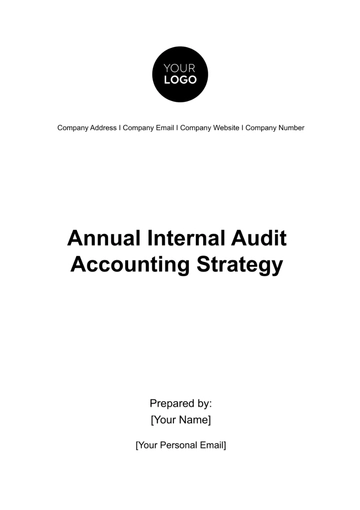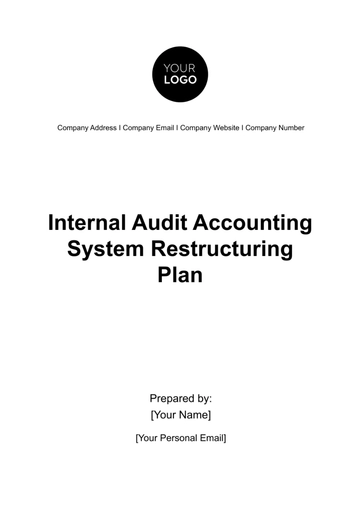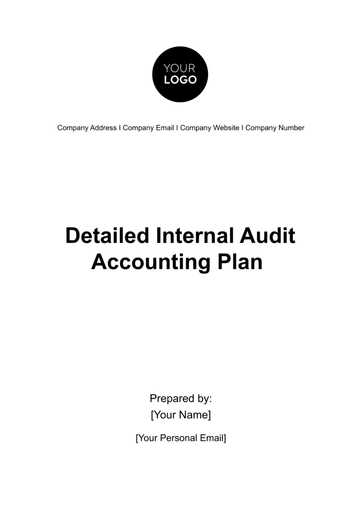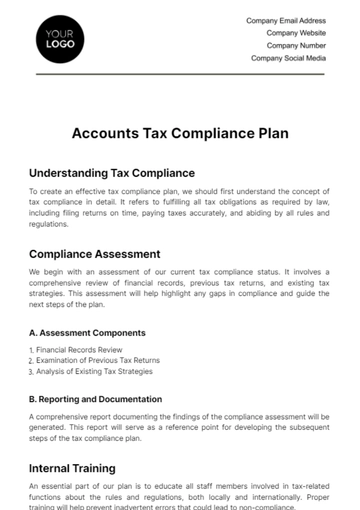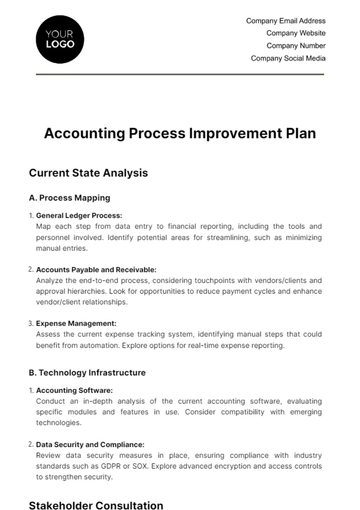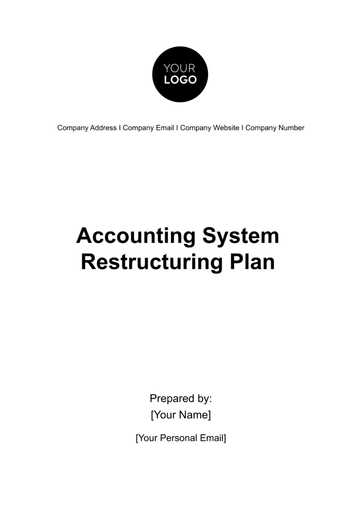Free Long-Term Internal Audit Accounting Strategy Plan

Executive Summary
This Long-Term Internal Audit Accounting Strategy Plan outlines our approach to enhancing the effectiveness, efficiency, and value of the internal audit function over the next five years. The plan’s primary purpose is to align the internal audit activities with our broader organizational strategy, focusing on areas of highest risk and opportunity for improvement. Key objectives include strengthening governance and control environments, improving risk management practices, and supporting organizational objectives through strategic audit planning and execution. The scope encompasses all areas of financial operations, compliance, and risk management, aiming to provide comprehensive coverage across our operational landscape. By executing this plan, we commit to fostering a culture of transparency, accountability, and continuous improvement, ensuring our organization remains resilient and adaptable to both current and future challenges.
Introduction
In the context of rapidly evolving business environments, regulatory landscapes, and technological advancements, our organization recognizes the critical need for a robust and forward-thinking internal audit function. The internal audit's role extends beyond traditional financial and compliance audits to encompass strategic advisory services that align with our long-term objectives and emerging risks. The importance of a long-term strategy for internal audit functions cannot be overstated; it enables proactive identification of risks, optimizes resource allocation, and enhances the overall decision-making process. This strategy plan is designed to guide our internal audit activities in a manner that is both strategic and adaptable, ensuring we not only safeguard against risks but also seize opportunities for improvement and innovation. Through this long-term strategic lens, we aim to enhance our governance, risk management, and control processes, contributing significantly to the achievement of our organizational goals.
Objectives of the Long-Term Audit Strategy
The primary objectives of our Long-Term Internal Audit Accounting Strategy Plan are as follows:
Enhance Risk Management: To systematically identify, assess, and manage risks across the organization, ensuring that strategic and operational risks are effectively mitigated.
Strengthen Governance and Control: To evaluate and improve the effectiveness of governance, risk management, and control processes, aligning them with industry best practices and regulatory requirements.
Support Organizational Objectives: To align internal audit activities with our long-term business objectives, providing assurance and advisory services that contribute to the achievement of these goals.
Optimize Resource Allocation: To ensure that internal audit resources are focused on areas of highest risk and potential impact, optimizing the use of audit resources and enhancing overall efficiency.
Promote a Culture of Compliance: To reinforce a strong compliance culture within the organization by regularly assessing adherence to laws, regulations, and internal policies, and by recommending improvements.
Foster Continuous Improvement: To identify opportunities for operational improvements and to facilitate the implementation of best practices across all areas of the organization.
Enhance Stakeholder Confidence: To provide assurance to the board, management, and external stakeholders that the organization is managing its risks effectively and operating efficiently.
By achieving these objectives, our internal audit function will not only protect organizational value but also enhance it by advising on and facilitating improvements in governance, risk management, and control processes.
Scope of the Strategy Plan
The Long-Term Internal Audit Accounting Strategy Plan encompasses a comprehensive scope that includes various areas of the organization’s operations and a wide range of audit types. Specifically, the scope covers:
Areas of the Organization's Operations
Financial Reporting and Management
Operational Processes
Information Technology
Compliance and Regulatory
Strategic Initiatives
Types of Audits to be Included
Financial Audits
Operational Audits
Compliance Audits
Strategic Audits
Risk-Based Audits
Advisory Services
This broad scope ensures that the internal audit function comprehensively addresses all critical aspects of the organization, leveraging a balanced mix of audit types to provide valuable insights and recommendations across all levels of the organization.
Audit Governance and Framework
Our internal audit function operates within a structured governance framework designed to ensure independence, objectivity, and alignment with organizational objectives. This framework establishes clear reporting lines to the Audit Committee and senior management, ensuring that internal audit activities are conducted without undue influence and that findings and recommendations are appropriately considered and acted upon. The framework also defines the standards, methodologies, and tools to be used in conducting audits, ensuring consistency and quality across all internal audit activities. It includes mechanisms for planning, executing, reporting, and following up on audit findings, as well as for communicating with stakeholders throughout the audit process.
Element | Description |
Reporting Lines | Internal audit reports functionally to the Audit Committee and administratively to the CEO. |
Audit Charter | A formal document that outlines the purpose, authority, and responsibility of the internal audit. |
Audit Standards | Adherence to internationally recognized audit standards such as the IIA Standards. |
Methodology and Tools | Utilization of both traditional and innovative audit methodologies and tools. |
Communication Plan | Defined processes for communicating audit findings, insights, and recommendations. |
Follow-Up Procedures | Systematic follow-up on audit findings to ensure effective implementation of recommendations. |
This governance framework and structured approach ensure that our internal audit function is equipped to provide valuable insights and recommendations that support the achievement of our organizational goals.
Risk Assessment and Audit Focus Areas
Our risk assessment process is integral to the internal audit strategy, ensuring that audit resources are focused on areas of highest risk and potential impact to the organization. This process involves a comprehensive evaluation of both internal and external factors that could affect the achievement of our objectives, with a particular focus on financial, operational, compliance, and strategic risks.
Risk Category | Description |
Financial Risk | Risks related to financial reporting, fraud, and financial performance. |
Operational Risk | Risks impacting the efficiency and effectiveness of operations and internal processes. |
Compliance Risk | Risks of non-compliance with laws, regulations, and internal policies. |
Strategic Risk | Risks that could affect the achievement of strategic objectives, including market and sector changes. |
Technological Risk | Risks associated with IT systems and cybersecurity threats. |
Analysis
In prioritizing these risks within our audit plan, we consider factors such as the likelihood of occurrence, potential impact on the organization, and the effectiveness of existing controls. Financial and compliance risks are often prioritized due to their direct impact on the integrity of our financial reporting and the potential for regulatory penalties. Operational and strategic risks are also critical, as they can significantly affect our ability to achieve our organizational goals. Technological risks are increasingly prioritized given the growing reliance on IT systems and the potential for cybersecurity incidents.
By focusing our audit efforts on these key risk areas, we ensure that our internal audit activities are aligned with the organization's risk profile and strategic objectives, providing the most value and supporting our long-term success.
Audit Methodology and Tools
Our audit methodology integrates traditional audit techniques with innovative approaches and technologies to ensure comprehensive and effective audit coverage. This blend allows us to not only assess compliance and controls but also to provide insights that can drive organizational improvement. We leverage a variety of tools to enhance the efficiency and effectiveness of our audit processes, from data analytics to automated audit management systems.
Tool Name | Purpose | Application |
Data Analytics Software | To analyze large datasets for patterns, anomalies, and trends. | Financial and operational audits. |
Audit Management System | For planning, executing, and tracking audits; managing findings. | Across all audit activities. |
Risk Assessment Tools | To identify and prioritize risks based on their potential impact. | Initial planning and ongoing assessment. |
Collaboration Platforms | To facilitate communication and document sharing among audit teams. | Throughout the audit process. |
Continuous Monitoring Software | For real-time monitoring of financial transactions and controls. | Primarily in high-risk areas. |
These tools are integral to enhancing our audit capabilities, allowing us to conduct more thorough and efficient audits and to provide valuable insights to management and the board.
Staffing and Professional Development Plan
Recognizing that the strength of our internal audit function lies in the skills and expertise of our team, we are committed to a comprehensive staffing and professional development plan. This plan is designed to ensure we have the necessary resources to achieve our audit objectives and that our staff are equipped with the latest knowledge and skills in the field.
Program Name | Objective | Target Audience |
Internal Audit Training Program | To update staff on the latest audit techniques and standards. | All internal audit staff. |
Professional Certification Support | To support staff in obtaining professional certifications (e.g., CPA, CIA). | Staff seeking certification. |
Leadership Development Program | To prepare senior audit staff for leadership roles within the function. | Senior audit staff. |
Technology Training Sessions | To ensure staff are proficient in using audit-related software and tools. | All staff, with focus on new hires. |
External Seminars and Workshops | To expose staff to external trends, challenges, and best practices. | Staff in specialized audit areas. |
These programs are designed to foster a culture of continuous learning and professional growth, ensuring our audit team remains at the forefront of the profession.
Budgetary Considerations
Adequate budgeting is crucial to support the effective implementation of our Long-Term Internal Audit Strategy Plan. The budget is structured to ensure sufficient resources are allocated to critical areas such as staffing, technology, training, and external support.
Budget Item | Estimated Cost (USD) | Description |
Personnel Costs | 500,000 | Salaries and benefits for audit staff. |
Technology & Software | 100,000 | Annual licenses for audit tools and software. |
Training & Development | 50,000 | Costs associated with professional development programs. |
External Audit Support | 75,000 | Fees for external experts or specialized audits. |
Miscellaneous | 25,000 | Travel, supplies, and unforeseen expenses. |
Total Estimated Budget: $750,000
This budget reflects our commitment to investing in the internal audit function to enhance its effectiveness and value to the organization. Through careful planning and resource allocation, we aim to ensure the internal audit team has the tools, skills, and support necessary to successfully execute the Long-Term Internal Audit Strategy Plan.
Schedule and Planning Cycle
Our Long-Term Internal Audit Strategy Plan includes a clearly defined schedule and planning cycle that outlines when and how audits will be conducted over the strategic period. This schedule is designed to ensure that all areas of the organization are audited in a timely and systematic manner, with flexibility built in to address emerging risks or areas of concern. The planning cycle includes regular risk assessments to adjust and align the audit plan with the organization's changing risk landscape.
Year | Focus Areas | Timing |
1 | Financial Reporting, Compliance | Q1 - Q2 |
1 | Operational Efficiency, IT Systems | Q3 - Q4 |
2 | Strategic Initiatives, Risk Management | Q1 - Q2 |
2 | Human Resources, External Compliance | Q3 - Q4 |
3 | Full Cycle Review, Special Projects | Throughout the year |
Updating the Audit Plan
Annual Risk Assessment: Conducted at the end of each fiscal year to identify changes in the risk landscape.
Stakeholder Feedback: Incorporate feedback from management and the Audit Committee to ensure alignment with organizational priorities.
Regulatory Changes: Update the plan in response to new or revised regulations that impact our operations.
Audit Findings Review: Adjust based on insights and recommendations from completed audits.
Mid-Year Review: A formal review to make necessary adjustments based on the first half of the year's findings and changes in organizational priorities.
Quality Assurance and Improvement Program
To ensure the highest standards of quality in our audit work, we have established a Quality Assurance and Improvement Program (QAIP) that encompasses various mechanisms:
Peer Reviews: Regular peer reviews of audit work to ensure adherence to internal standards and methodologies.
External Quality Assessments: Engaging external auditors to review our audit practices and provide objective feedback every three years.
Continuous Professional Education: Mandating ongoing education for audit staff to keep abreast of auditing standards, regulations, and best practices.
Internal Audit Manual Updates: Regularly updating the audit manual to reflect current best practices and lessons learned from audit engagements.
Performance Metrics: Monitoring and evaluating audit performance against defined metrics and goals to identify areas for improvement.
Communication and Reporting
Effective communication and reporting are critical components of our internal audit function, ensuring transparency and facilitating action on audit findings and recommendations.
Regular Updates to Management and the Audit Committee: Provide ongoing updates on audit findings, progress against the audit plan, and risk management issues.
Annual Audit Summary Report: A comprehensive report summarizing audit activities, findings, and recommendations for the fiscal year, presented to the Audit Committee and senior management.
Management Response Tracking: Implement a system for tracking management's responses and actions taken on audit recommendations, including timelines for implementation.
Stakeholder Engagement: Engage with various stakeholders throughout the audit process to gather insights, share findings, and discuss recommendations.
Use of Technology for Reporting: Leverage audit management software to streamline reporting processes, ensuring timely and efficient communication of audit results.
Monitoring and Evaluation
To ensure the Long-Term Internal Audit Accounting Strategy Plan is effectively meeting its objectives and contributing to the organization's overall goals, a comprehensive monitoring and evaluation framework has been established. This framework employs specific metrics to assess performance, track progress, and identify areas for improvement in the internal audit function. Regular assessments against these metrics enable us to refine our approach, methodologies, and focus areas in alignment with evolving organizational needs and the external environment.
Metric | Target |
Audit Coverage Ratio | 100% coverage of planned audit areas annually |
Implementation Rate of Recommendations | >90% of audit recommendations implemented within agreed timelines |
Stakeholder Satisfaction | ≥85% satisfaction rate in annual surveys |
Audit Cycle Time | Reduction in average audit cycle time by 10% year-over-year |
Training Hours per Auditor | Minimum of 40 hours of professional development per auditor annually |
Compliance with Audit Standards | 100% adherence to internal and external audit standards |
Analysis
The target metrics outlined above serve as key indicators of the internal audit function's performance and effectiveness. By achieving these targets, we ensure that our internal audit activities are comprehensive, recommendations are acted upon in a timely manner, and our team remains highly skilled and knowledgeable. The metrics also reflect our commitment to stakeholder engagement and adherence to the highest standards of audit practice. Regular analysis of these metrics allows us to identify trends, pinpoint areas requiring attention, and make informed decisions to continuously enhance the value delivered by the internal audit function. This ongoing monitoring and evaluation process is crucial for maintaining the relevance and effectiveness of our internal audit strategy in supporting the organization's strategic objectives.
Conclusion
The Long-Term Internal Audit Accounting Strategy Plan sets forth a comprehensive roadmap designed to enhance the value and effectiveness of the internal audit function over the next several years. By aligning our objectives with the organization's strategic goals, focusing on areas of highest risk, and employing a robust governance framework, we are well-positioned to provide critical insights and recommendations that support the achievement of operational excellence and strategic success. Through the implementation of this plan, including the use of advanced methodologies and tools, focused professional development, and a commitment to quality and continuous improvement, we will strengthen our internal controls, risk management, and governance processes. The plan’s dynamic nature, coupled with a systematic approach to monitoring and evaluation, ensures that our internal audit function remains agile, responsive, and capable of addressing both current and future challenges. We are committed to upholding the highest standards of audit practice and integrity, thereby enhancing stakeholder confidence and contributing to the sustained success of our organization.
- 100% Customizable, free editor
- Access 1 Million+ Templates, photo’s & graphics
- Download or share as a template
- Click and replace photos, graphics, text, backgrounds
- Resize, crop, AI write & more
- Access advanced editor
Optimize your auditing future with the Long-Term Internal Audit Accounting Strategy Plan Template from Template.net. This editable and customizable template is a strategic asset for your internal audit function over the long term. Editable in our AI Editor tool, it provides the versatility to craft a plan that aligns with your organization's evolving goals and challenges.
You may also like
- Finance Plan
- Construction Plan
- Sales Plan
- Development Plan
- Career Plan
- Budget Plan
- HR Plan
- Education Plan
- Transition Plan
- Work Plan
- Training Plan
- Communication Plan
- Operation Plan
- Health And Safety Plan
- Strategy Plan
- Professional Development Plan
- Advertising Plan
- Risk Management Plan
- Restaurant Plan
- School Plan
- Nursing Home Patient Care Plan
- Nursing Care Plan
- Plan Event
- Startup Plan
- Social Media Plan
- Staffing Plan
- Annual Plan
- Content Plan
- Payment Plan
- Implementation Plan
- Hotel Plan
- Workout Plan
- Accounting Plan
- Campaign Plan
- Essay Plan
- 30 60 90 Day Plan
- Research Plan
- Recruitment Plan
- 90 Day Plan
- Quarterly Plan
- Emergency Plan
- 5 Year Plan
- Gym Plan
- Personal Plan
- IT and Software Plan
- Treatment Plan
- Real Estate Plan
- Law Firm Plan
- Healthcare Plan
- Improvement Plan
- Media Plan
- 5 Year Business Plan
- Learning Plan
- Marketing Campaign Plan
- Travel Agency Plan
- Cleaning Services Plan
- Interior Design Plan
- Performance Plan
- PR Plan
- Birth Plan
- Life Plan
- SEO Plan
- Disaster Recovery Plan
- Continuity Plan
- Launch Plan
- Legal Plan
- Behavior Plan
- Performance Improvement Plan
- Salon Plan
- Security Plan
- Security Management Plan
- Employee Development Plan
- Quality Plan
- Service Improvement Plan
- Growth Plan
- Incident Response Plan
- Basketball Plan
- Emergency Action Plan
- Product Launch Plan
- Spa Plan
- Employee Training Plan
- Data Analysis Plan
- Employee Action Plan
- Territory Plan
- Audit Plan
- Classroom Plan
- Activity Plan
- Parenting Plan
- Care Plan
- Project Execution Plan
- Exercise Plan
- Internship Plan
- Software Development Plan
- Continuous Improvement Plan
- Leave Plan
- 90 Day Sales Plan
- Advertising Agency Plan
- Employee Transition Plan
- Smart Action Plan
- Workplace Safety Plan
- Behavior Change Plan
- Contingency Plan
- Continuity of Operations Plan
- Health Plan
- Quality Control Plan
- Self Plan
- Sports Development Plan
- Change Management Plan
- Ecommerce Plan
- Personal Financial Plan
- Process Improvement Plan
- 30-60-90 Day Sales Plan
- Crisis Management Plan
- Engagement Plan
- Execution Plan
- Pandemic Plan
- Quality Assurance Plan
- Service Continuity Plan
- Agile Project Plan
- Fundraising Plan
- Job Transition Plan
- Asset Maintenance Plan
- Maintenance Plan
- Software Test Plan
- Staff Training and Development Plan
- 3 Year Plan
- Brand Activation Plan
- Release Plan
- Resource Plan
- Risk Mitigation Plan
- Teacher Plan
- 30 60 90 Day Plan for New Manager
- Food Safety Plan
- Food Truck Plan
- Hiring Plan
- Quality Management Plan
- Wellness Plan
- Behavior Intervention Plan
- Bonus Plan
- Investment Plan
- Maternity Leave Plan
- Pandemic Response Plan
- Succession Planning
- Coaching Plan
- Configuration Management Plan
- Remote Work Plan
- Self Care Plan
- Teaching Plan
- 100-Day Plan
- HACCP Plan
- Student Plan
- Sustainability Plan
- 30 60 90 Day Plan for Interview
- Access Plan
- Site Specific Safety Plan


